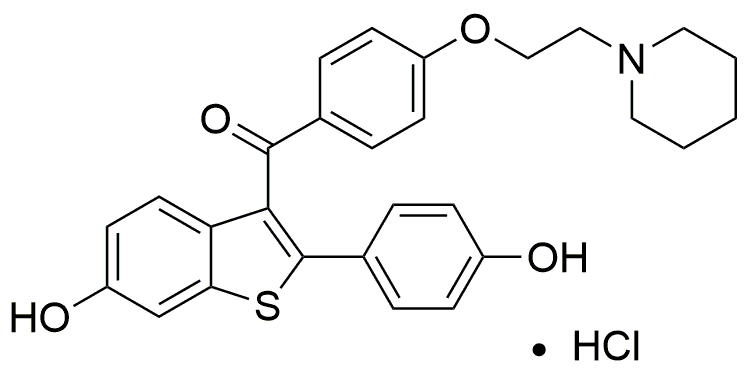Raloxifene hydrochloride is widely utilized in research focused on:
- Osteoporosis Treatment: Commonly prescribed to postmenopausal women, it helps reduce the risk of spinal fractures by mimicking estrogen's beneficial effects on bone density.
- Breast Cancer Prevention: It is used as a preventive treatment for women at high risk of breast cancer, offering an alternative to traditional hormone replacement therapies.
- Cardiovascular Health: Research indicates that it may improve lipid profiles, thereby potentially reducing the risk of heart disease in postmenopausal women.
- Clinical Trials: Frequently involved in clinical studies assessing its efficacy and safety, providing valuable data for future therapeutic applications.
- Research on Hormonal Therapies: Serves as a crucial compound in studies exploring selective estrogen receptor modulators (SERMs), contributing to advancements in hormone-related treatments.
General Information
Properties
Safety and Regulations
Applications
Raloxifene hydrochloride is widely utilized in research focused on:
- Osteoporosis Treatment: Commonly prescribed to postmenopausal women, it helps reduce the risk of spinal fractures by mimicking estrogen's beneficial effects on bone density.
- Breast Cancer Prevention: It is used as a preventive treatment for women at high risk of breast cancer, offering an alternative to traditional hormone replacement therapies.
- Cardiovascular Health: Research indicates that it may improve lipid profiles, thereby potentially reducing the risk of heart disease in postmenopausal women.
- Clinical Trials: Frequently involved in clinical studies assessing its efficacy and safety, providing valuable data for future therapeutic applications.
- Research on Hormonal Therapies: Serves as a crucial compound in studies exploring selective estrogen receptor modulators (SERMs), contributing to advancements in hormone-related treatments.
Documents
Safety Data Sheets (SDS)
The SDS provides comprehensive safety information on handling, storage, and disposal of the product.
Product Specification (PS)
The PS provides a comprehensive breakdown of the product’s properties, including chemical composition, physical state, purity, and storage requirements. It also details acceptable quality ranges and the product's intended applications.
Certificates of Analysis (COA)
Search for Certificates of Analysis (COA) by entering the products Lot Number. Lot and Batch Numbers can be found on a product’s label following the words ‘Lot’ or ‘Batch’.
*Catalog Number
*Lot Number
Certificates Of Origin (COO)
This COO confirms the country where the product was manufactured, and also details the materials and components used in it and whether it is derived from natural, synthetic, or other specific sources. This certificate may be required for customs, trade, and regulatory compliance.
*Catalog Number
*Lot Number
Safety Data Sheets (SDS)
The SDS provides comprehensive safety information on handling, storage, and disposal of the product.
DownloadProduct Specification (PS)
The PS provides a comprehensive breakdown of the product’s properties, including chemical composition, physical state, purity, and storage requirements. It also details acceptable quality ranges and the product's intended applications.
DownloadCertificates of Analysis (COA)
Search for Certificates of Analysis (COA) by entering the products Lot Number. Lot and Batch Numbers can be found on a product’s label following the words ‘Lot’ or ‘Batch’.
*Catalog Number
*Lot Number
Certificates Of Origin (COO)
This COO confirms the country where the product was manufactured, and also details the materials and components used in it and whether it is derived from natural, synthetic, or other specific sources. This certificate may be required for customs, trade, and regulatory compliance.


